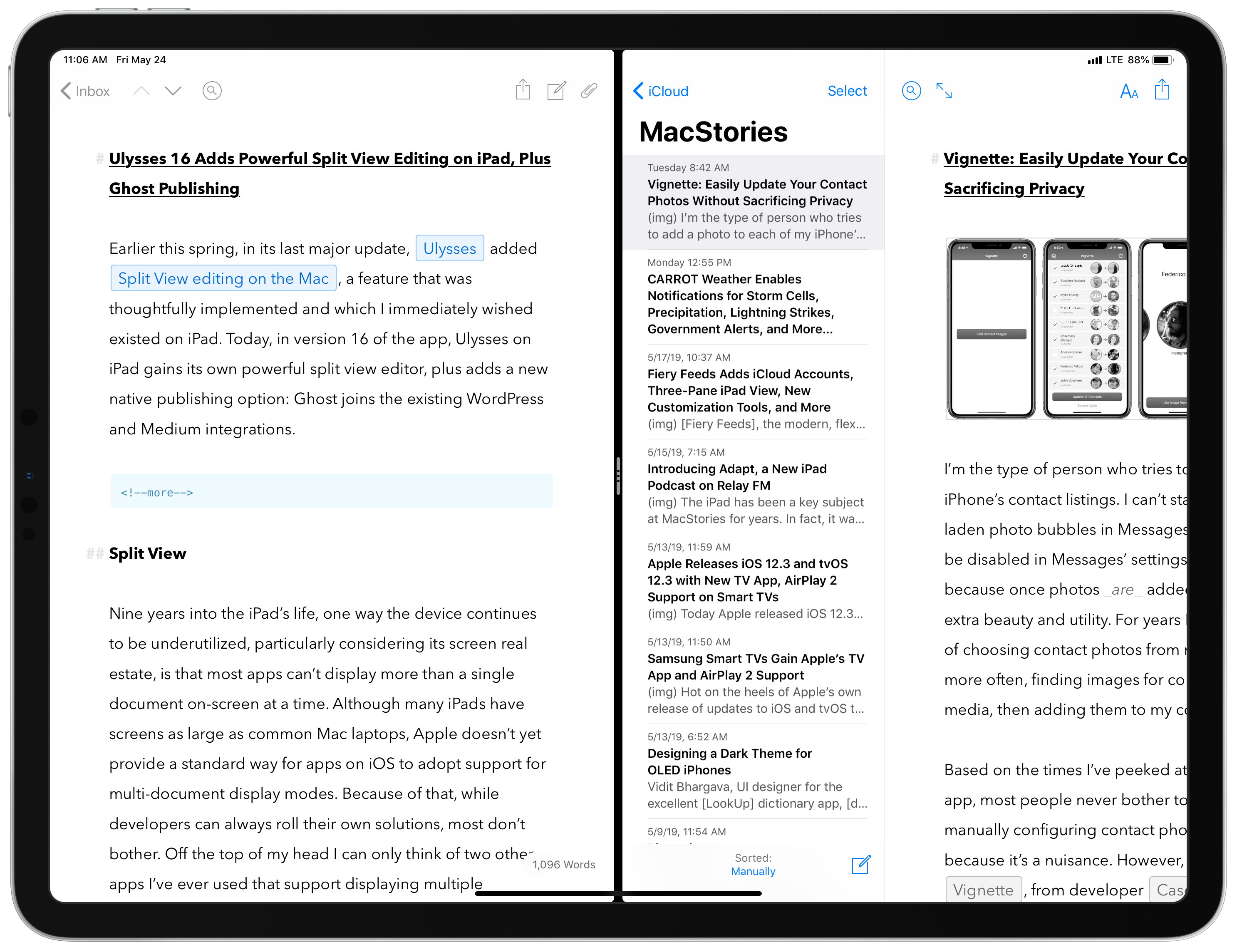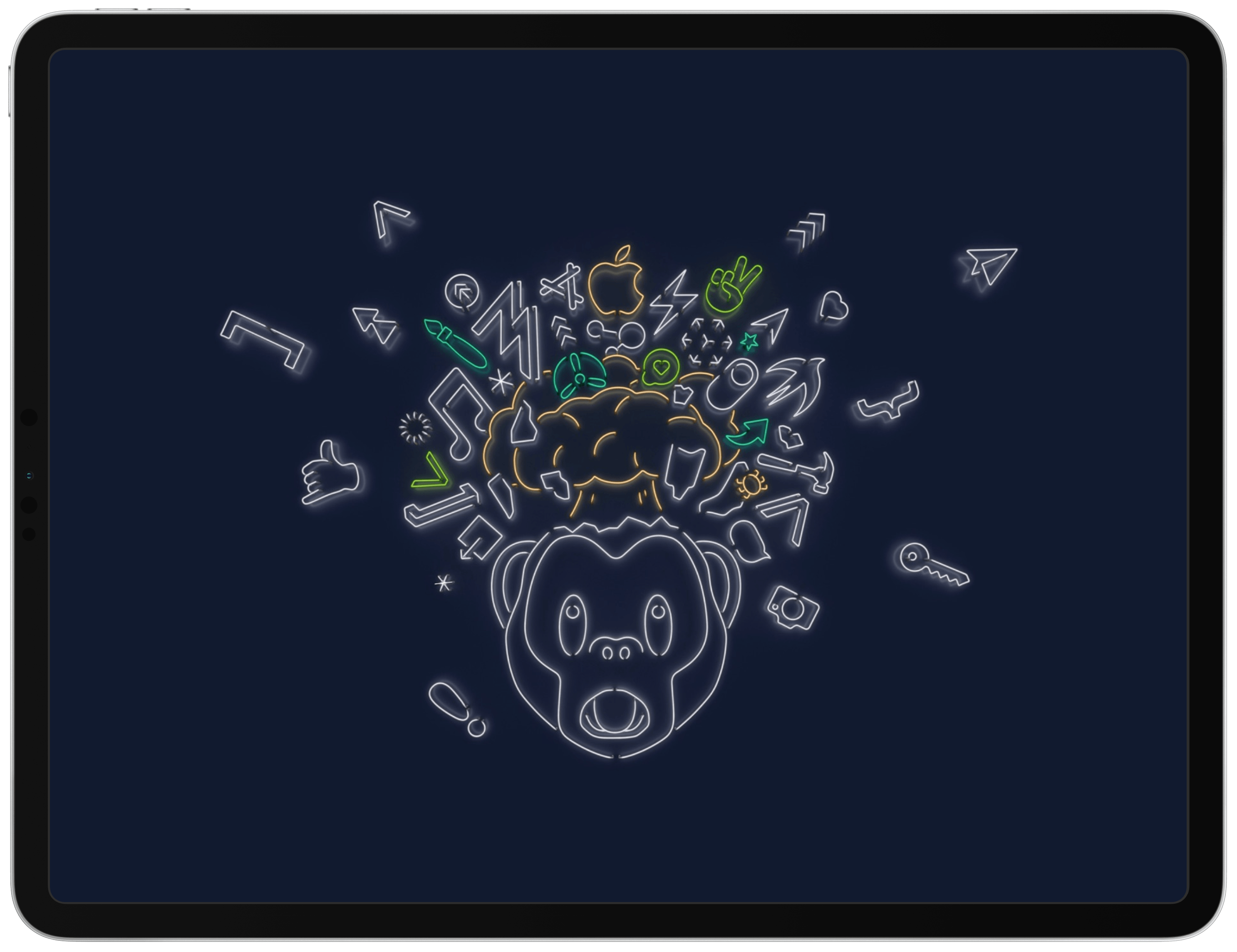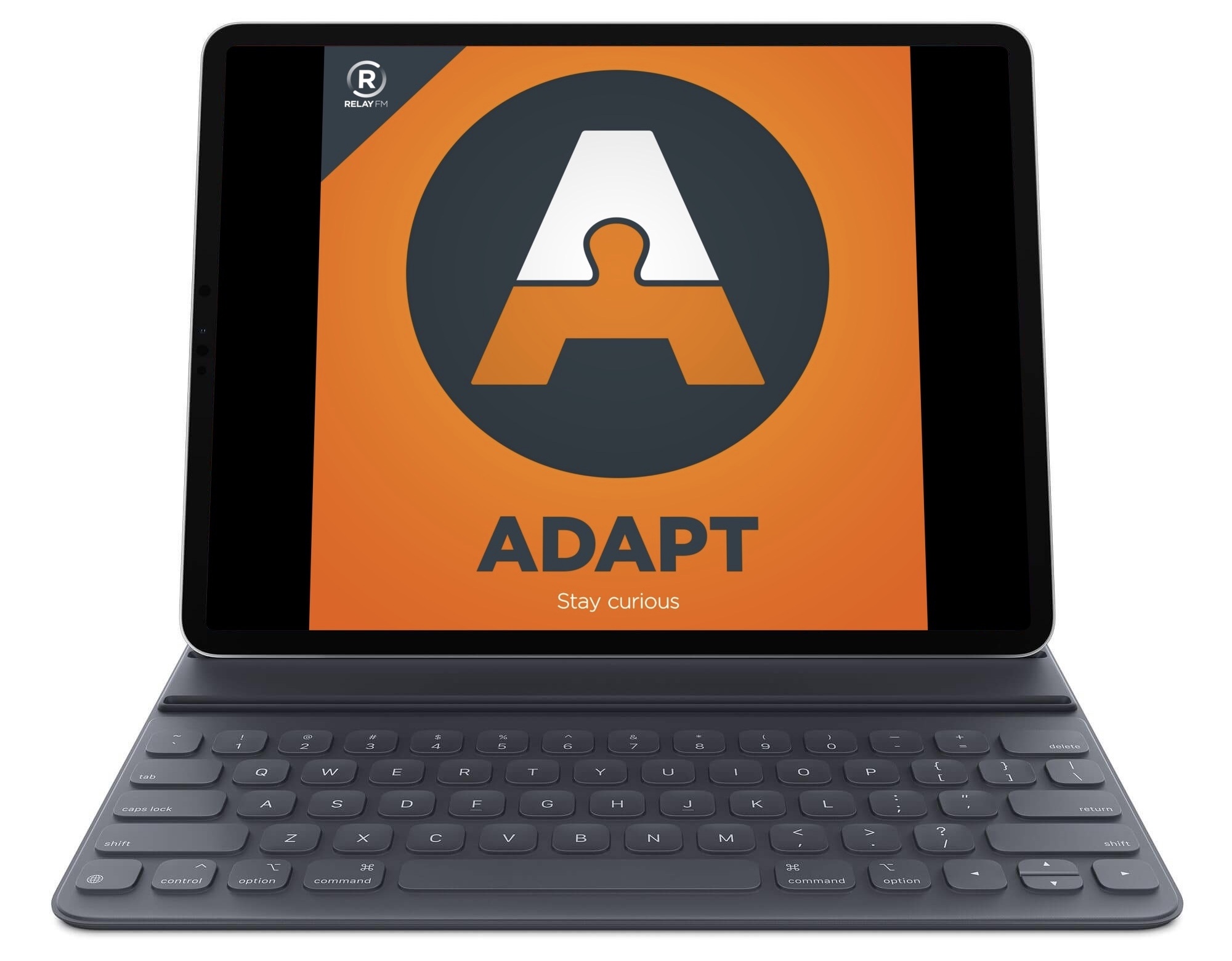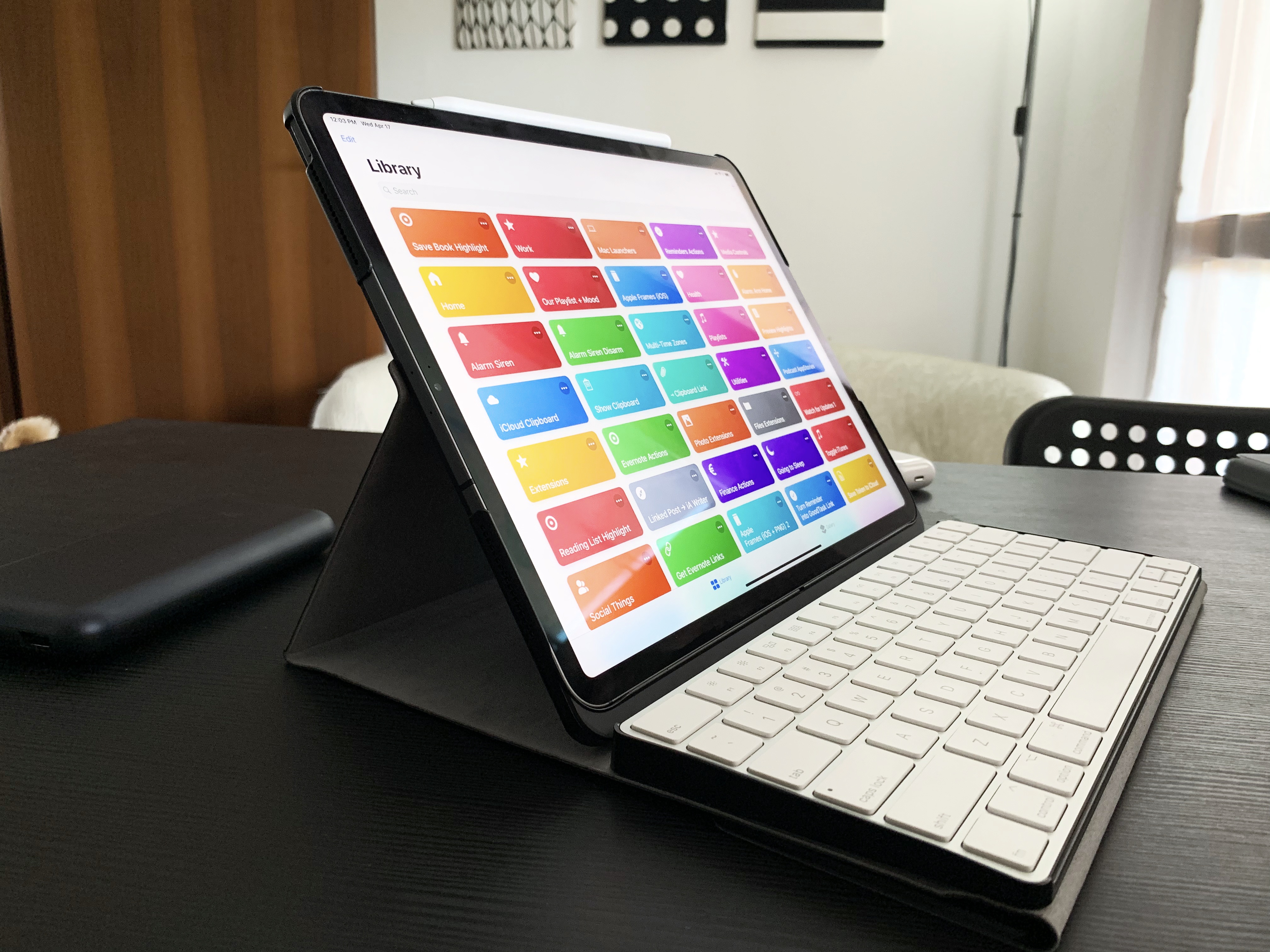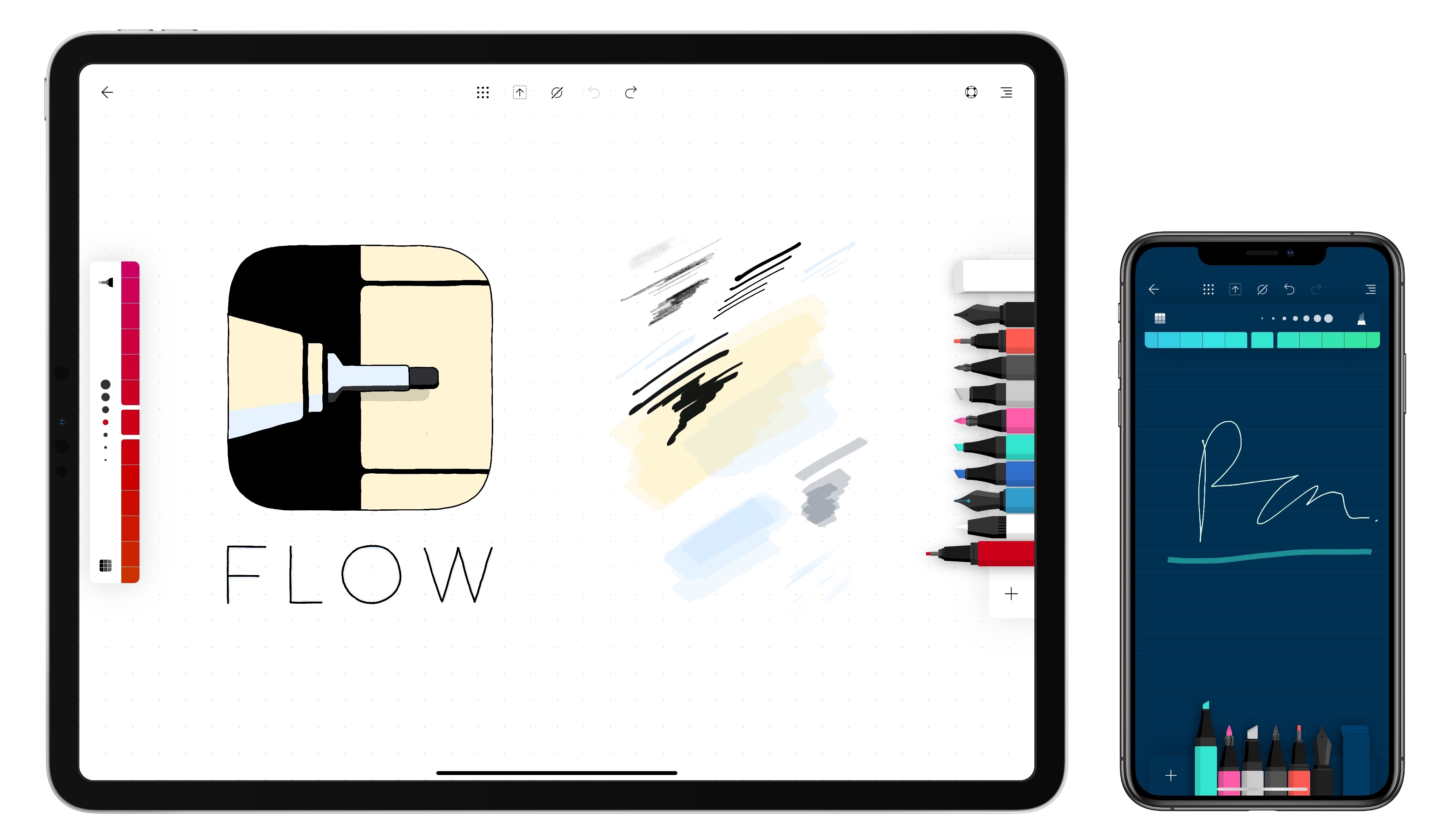Earlier this spring, in its last major update, Ulysses added Split View editing on the Mac, a feature that was thoughtfully implemented and which I immediately wished existed on iPad. Today, in version 16 of the app, Ulysses on iPad gains its own powerful split view editor, plus adds a new native publishing option: Ghost joins the existing WordPress and Medium integrations.
Posts tagged with "iPad"
Ulysses 16 Adds Powerful Split View Editing on iPad, Plus Ghost Publishing
WWDC, A Wish List (2019 Edition)
Way back in 2016, in the era of iOS 9, I laid out the tentpole features I wanted to see come to iOS and the Mac. Now, three years later, so many things from that wishlist have become a reality that it’s probably a good time to revisit the topics that haven’t yet come to pass, and plan a new wishlist for the years to come. I originally planned this list to have a Developer/User split, but it became clear that the two go hand-in-hand; if you’re doing complex things on iOS today, using the various automation apps, you are but steps away from needing the same things that developers do.
Beyond the Tablet Extras: eBook, Special Episode of AppStories, and Making Of Essays
Today, Federico published Beyond the Tablet: Seven Years of iPad as My Main Computer, a comprehensive evaluation of the advantages and shortcomings he’s experienced using an iPad as his primary computer. Weighing in at around 50,000 words, Beyond the Tablet rivals Federico’s annual iOS reviews in scope and depth of coverage. As a result, it felt appropriate to release the same sort of extras for this story that we’ve provided for iOS reviews.
Beyond the Tablet: Seven Years of iPad as My Main Computer
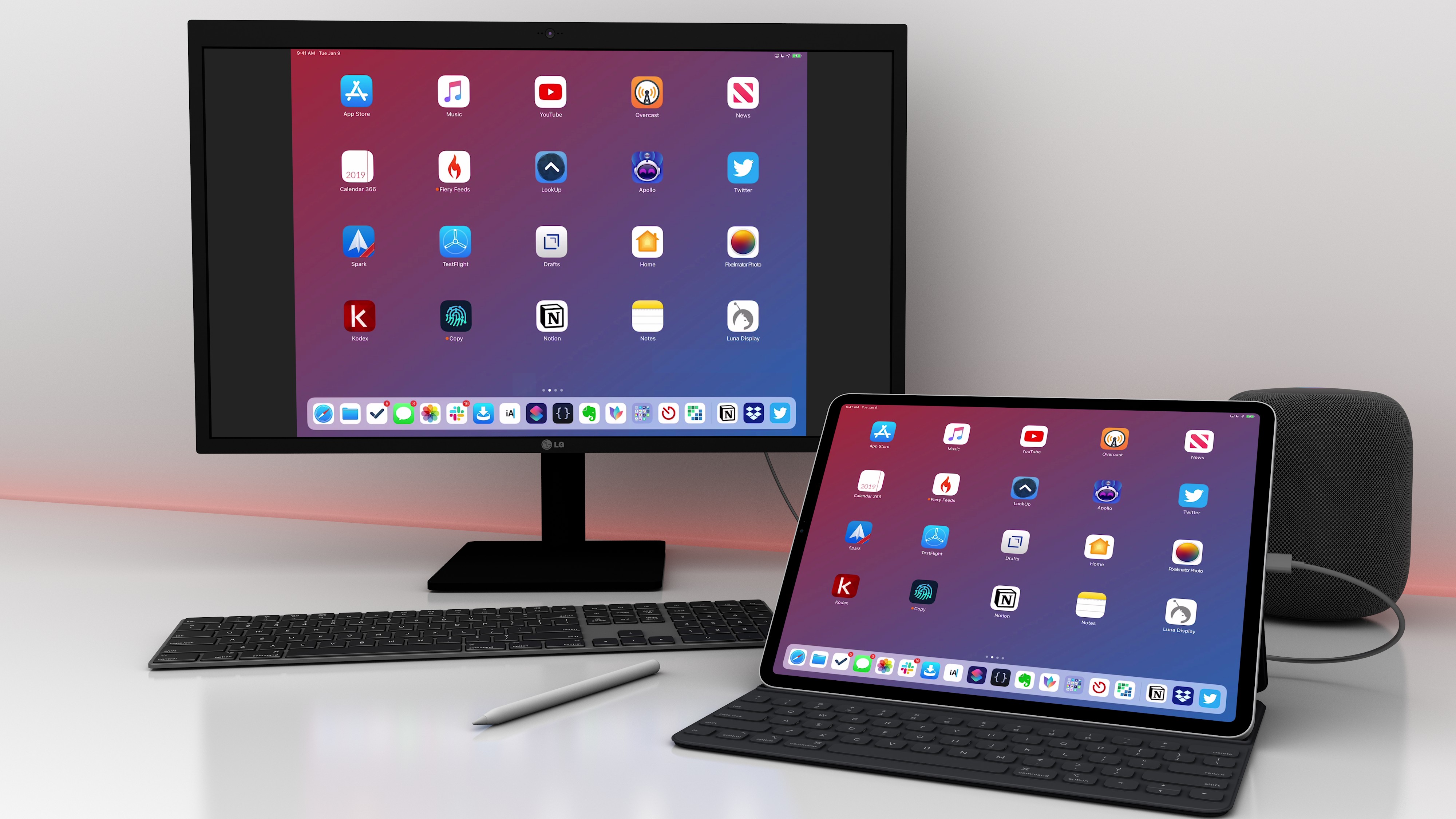
For the past seven years, I’ve considered the iPad my main computer. Not my only one, and not the most powerful one I own, but the computer which I use and enjoy using the most.
I’ve told this story on various occasions before, but it’s worth mentioning for context once again. My iPad journey began in 2012 when I was undergoing cancer treatments. In the first half of the year, right after my diagnosis, I was constantly moving between hospitals to talk to different doctors and understand the best strategies for my initial round of treatments. Those chemo treatments, it turned out, often made me too tired to get any work done. I wanted to continue working for MacStories because it was a healthy distraction that kept my brain busy, but my MacBook Air was uncomfortable to carry around and I couldn’t use it in my car as it lacked a cellular connection. By contrast, the iPad was light, it featured built-in 3G, and it allowed me to stay in touch with the MacStories team from anywhere, at any time with the comfort of a large, beautiful Retina display.
The tipping point came when I had to be hospitalized for three consecutive weeks to undergo aggressive chemo treatments; in that period of time, I concluded that the extreme portability and freedom granted by the iPad had become essential for me. I started exploring the idea of using the iPad as my primary computer (see this story for more details); if anything were to ever happen to me again that prevented being at my desk in my home office, I wanted to be prepared. That meant embracing iOS, iPad apps, and a different way of working on a daily basis.
I realized when writing this story that I’ve been running MacStories from my iPad for longer than I ever ran it from a Mac. The website turned 10 last month, and I’ve managed it almost exclusively from an iPad for seven of those years. And yet, I feel like I’m still adapting to the iPad lifestyle myself – I’m still figuring out the best approaches and forcing myself to be creative in working around the limitations of iOS.
On one hand, some may see this as an indictment of Apple’s slow evolution of the iPad platform, with biennial tablet-focused iOS releases that have left long-standing issues still yet to be fixed. And they’re not wrong: I love working from my iPad, but I recognize how some aspects of its software are still severely lagging behind macOS. On the other hand, I won’t lie: I’ve always enjoyed the challenge of “figuring out the iPad” and pushing myself to be creative and productive in a more constrained environment.
In addition to discovering new apps I could cover on MacStories, rethinking how I could work on the iPad provided me with a mental framework that I likely wouldn’t have developed on a traditional desktop computer. If I was in a hospital bed and couldn’t use a Mac, that meant someone else from the MacStories team had to complete a specific, Mac-only task. In a way, the limitations of the iPad taught me the importance of delegation – a lesson I was forced into. As a result, for the first couple of years, the constrained nature of the iPad helped me be more creative and focused on my writing; before the days of Split View and drag and drop, the iPad was the ideal device to concentrate on one task at a time.
Over the following couple of years, I learned how to navigate the iPad’s limitations and started optimizing them to get more work done on the device (I was also cancer-free, which obviously helped). This is when I came across the iOS automation scene with apps such as Pythonista, Editorial, Drafts, and eventually Workflow. Those apps, despite the oft-unreliable nature of their workarounds, enabled me to push iOS and the iPad further than what Apple had perhaps envisioned for the device at the time; in hindsight, building hundreds of automations for Workflow prepared me for the bold, more powerful future of Shortcuts. Automation isn’t supposed to replace core functionality of an operating system; normally, it should be an enhancement on the side, an addition for users who seek the extra speed and flexibility it provides. Yet years ago, those automation apps were the only way to accomplish more serious work on the iPad. I’m glad I learned how to use them because, at the end of the day, they allowed me to get work done – even though it wasn’t the easiest or most obvious path.
When Apple announced the iPad Pro in 2015, it felt like a vindication of the idea that, for lots of iOS users – myself included – it was indeed possible to treat the iPad as a laptop replacement. And even though not much has changed (yet?) since 2017’s iOS 11 in terms of what the iPad Pro’s software can do, the modern iPad app ecosystem is vastly different from the early days of the iPad 3 and iOS 5, and that’s all thanks to the iPad Pro and Apple’s push for pro apps and a financially-viable App Store.
We now have professional apps such as Ulysses, Agenda, Things, Keep It, and iA Writer, which, in most cases, boast feature parity with their Mac counterparts; we have examples of iOS-only pro tools like Pixelmator Photo, LumaFusion, Shortcuts, and Working Copy, which are ushering us into a new era of mobile productivity; and both from a pure iPad-hardware and accessory standpoint, we have more choice than ever thanks to a larger, more inclusive iPad lineup, remarkable Pro hardware, and solid options to extend the iPad via keyboards, USB-C accessories, and more.
Seven years after I started (slowly) replacing my MacBook Air with an iPad, my life is different, but one principle still holds true: I never want to find myself forced to work on a computer that’s only effective at home, that can’t be held in my hands, or that can’t be customized for different setups. For this reason, the iPad Pro is the best computer for the kind of lifestyle I want.
However, the iPad is not perfect. And so in the spirit of offering one final update before WWDC and the massive release for iPad that iOS 13 will likely be, I thought I’d summarize seven years of daily iPad usage in one article that details how I work from the device and how I’d like the iPad platform to improve in the future.
In this story, I will explore four different major areas of working on the iPad using iOS 12 system features, third-party apps, and accessories. I’ll describe how I optimized each area to my needs, explain the solutions I implemented to work around the iPad’s software limitations, and argue how those workarounds shouldn’t be necessary anymore as the iPad approaches its tenth anniversary.
Consider this my iPad Manifesto, right on the cusp of WWDC. Let’s dive in.
Introducing Adapt, a New iPad Podcast on Relay FM
The iPad has been a key subject at MacStories for years. In fact, it was Federico’s exploration of using the iPad as his primary computer that first led me to become a reader of the site, and subsequently an iPad-first user myself.
Today, I’m thrilled to introduce a new podcast on Relay FM where Federico and I get to talk about the iPad and challenge ourselves to do new things with our favorite device. The show is called Adapt, and the first episode is available now.
Adapt was born out of a love for the iPad, and a desire to continue pushing our own use of it forward. Federico formerly hosted an iPad-focused podcast with Fraser Speirs called Canvas, but since that show ended Federico and I have been dreaming up its spiritual successor, with a similar focus on the iPad but a unique new format.
The Bittersweet iOS Document Browser→
Thoughtful, well-researched analysis of the iOS document browser by Matej Bukovinski, one of the developers of PDF Viewer for iOS, which was among the first apps to support the feature back in 2017:
It’s been about a year and half since iOS 11 was released into the wild, and with it, the long-awaited system document browser. PDF Viewer was one of the first applications that truly went all in with this new component, and we did this by fully replacing our custom solution with it on devices that were upgraded to iOS 11. This move certainly got us a lot of attention and praise from power users, but it also caused a lot of frustration for others who were unlucky enough to stumble upon the bugs and limitations of this new component. From a developer’s point of view, it was a mixed bag as well. On one hand, it allowed us to stop developing our custom document browser, thereby saving ourselves a lot of valuable development time in the process. On the other hand, it forced us to make do with a system we did not own and couldn’t even “hack” around when there were problems.
PDF Viewer will drop support for iOS 10 shortly, which will get rid of the final remains of our custom document browser, so we thought it might be a good time to take a closer look at how its system replacement is doing and go over the good, the bad, and the ugly.
File management is one of the main sections of an in-depth iPad story I’m working on right now, and the document browser is a key functionality I’m going to describe in detail. Overall, I agree with Bukovinski’s take: the document browser has brought consistency and speed to a lot of document-based apps, and I’m happy to see fewer custom file managers in apps these days, but it could use more customization options for developers, and the reliability of third-party file provider extensions is still largely hit or miss.
Review: Touchtype Pro Offers an Ingenious All-in-One Solution for iPad Pro and Magic Keyboard Users
The Touchtype Pro is a clever new accessory created by Salman Sajid that aims to combine the iPad Pro with Apple’s Magic Keyboard using a flexible cover case and magnets. Sajid launched a campaign for the product earlier this month on Kickstarter, where you can check out more details about pricing and the design process of the Touchtype Pro. I was lucky enough to get my hands on an early production unit before the Kickstarter went live and I’ve been using the Touchtype Pro with my 2018 12.9” iPad Pro for the past few weeks. After sharing some first impressions on Connected, I wanted to post a few more thoughts here, along with some photos.
Moleskine Flow Review: An Elegant, Accessible Digital Notebook for iPad and iPhone
One strength of an analog notebook is its simplicity. The times in my life when I’ve used a notebook regularly, I would always keep a pen attached to the notebook so that the process of writing involved just two simple steps: open the cover, and press pen to paper. Many digital notebook apps forfeit this simplicity due to overly complex interfaces and toolsets.
Moleskine’s new app, Flow, is a digital notebook that understands what it takes to succeed as a notebook replacement – giving you the tools to customize your experience to your own preferences. It’s available on both iPad and iPhone, and offers an elegant balance of convenience and flexibility that make it my favorite digital notebook to date.
The 10.5-inch iPad Air and Fifth-Generation iPad mini: The MacStories Overview
Today Apple has updated its online store with two major new products now available: an iPad Air with a 10.5” display, and a long-overdue fifth-generation iPad mini that includes Apple Pencil support.


